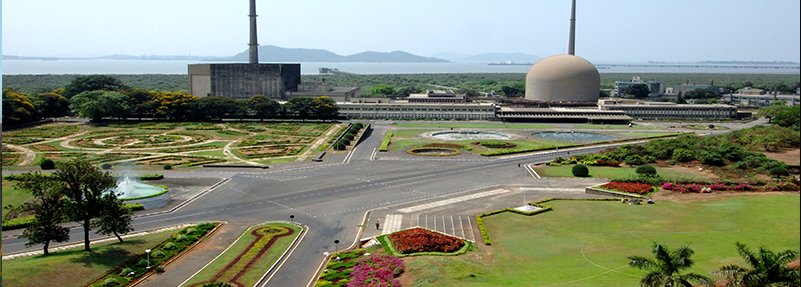DAE Outlines Nuclear Led Pathway for India's Clean Energy, Reaffirms 100 GW Target by 2047
Ahead of the maiden Emerging Science, Technology, and Innovation Conclave (ESTIC 2025), the Department of Atomic Energy (DAE) is reaffirming its strategic push for nuclear power, reiterating its goal of achieving 100 GW capacity by 2047.

30 October, 2025 Delhi/ Mumbai: Ahead of the maiden Emerging Science, Technology, and Innovation Conclave (ESTIC 2025), the Department of Atomic Energy (DAE) is reaffirming its strategic push for nuclear power, reiterating its goal of achieving 100 GW capacity by 2047.
The conclave, India's first integrated Science, Technology, and Innovation platform, is being organized to advance a core principle often articulated by Dr Jitendra Singh, Union Minister of State (Independent Charge) for Science & Technology: “The objective is clear: shorten the distance from the laboratory to the field and from a promising prototype to a dependable public-facing solution.”” As a key organiser, DAE will lead the thematic session on “Energy, Environment and Climate” at ESTIC, which aims to operationalize this vision.
Join PSU Connect on WhatsApp now for quick updates! Whatsapp Channel
Read Also : Job vacancies at NTPC Mining Limited (NML)This ambitious roadmap is positioned to underpin India's $30 trillion economic ambitions and fulfil its climate commitments. It addresses the nation's core energy challenge of powering a projected near-tripling of energy demand to 28,000 TWh by 2047, from the current 10,500 TWh, without exacerbating environmental concerns.
Outlining the department's role in this mission, Dr. Ajit Kumar Mohanty, Secretary, DAE, said during a virtual curtain-raiser on Thursday,"
Read Also : NTPC Bongaigaon organized National Unity Day and as part of Vigilance Awareness Week 2025“DAE is positioned as a key enabler by scaling reliable and zero-emission nuclear power capacity to 100 GW by 2047. Our ministry is delivering on the mandate of producing nuclear power, capacity building for nuclear power, creation and operation of research reactors. Our vision necessitates a broad-based shift towards a clean energy mix. This is essential not only to augment our national generation capacity but to systematically accomplish our ambitious goal of reaching net-zero emissions by 2070.”
As ministries, innovators, global visionaries, policymakers, and strategists are coming together at ESTIC, I am confident that this will serve as a platform for providing a broader vision towards Viksit Bharat@2047 in all aspects, he added.
The 100 GW nuclear vision entails a diversified approach, incorporating large indigenous reactors, international collaborations, and a significant push for Small Modular Reactors (SMRs) and advanced technologies like fast breeder systems and thorium-based fuels.
The foundation for this growth is robust. In the last decade, nuclear electricity generation has increased by about 60%, with installed capacity rising 71% to 8,880 MW. The operating fleet of 25 reactors has consistently maintained a Capacity Factor and Availability Factor above 80% over the past five years.
The foundation for this growth is robust. In the last decade, nuclear electricity generation has increased by about 60%, with installed capacity rising 71% to 8,880 MW. The operating fleet of 25 reactors has consistently maintained a Capacity Factor and Availability Factor above 80% over the past five years, with continuous operation beyond one year recorded 52 times (including 4 stints beyond two years).
Recent milestones include the commissioning of three indigenous 700 MWe PHWRs—KAPP-3, KAPS-4, and RAPP-7—with 13,100 MWe of additional capacity under construction. Policy reforms such as the creation of the Indian Nuclear Insurance Pool and amendments to the Atomic Energy Act are enabling public sector joint ventures. The ASHVINI JV (NPCIL-NTPC) has received siting consent at Mahi Banswara for a 4x700 MWe PHWR project, with environmental clearance accorded and foundation stone laid on September 25, 2025.
Further initiatives include an RFP for 220 MWe 'Bharat Small Reactors' to decarbonize hard-to-abate sectors and a ₹20,000 crore Nuclear Energy Mission to deploy five SMRs by 2033, with amendments to the Atomic Energy Act 1962 and CLND Act 2010 planned to enable private participation.
DAE's contributions extend beyond power generation through its network of Six Research Centres, Five PSUs, and aided institutions. Recent achievements include the APSARA-U research reactor, Demonstration Fast Reactor Fuel Reprocessing Plant (DFRP), and a Molybdenum-99 plant for medical isotopes. Radiation technology at upgraded KRUSHAK facility is enhancing food safety for products like onions and mangoes, with a record 2,500 tonnes shipped to the USA in 2023. Strategic projects like the Electronics Grade Boron-11 Enrichment Facility support semiconductor manufacturing, while production of Sm-Co Rare Earth Permanent Magnets and rare-earth metals at BARC, Vizag continues. In healthcare, the National Cancer Grid has expanded to 370 centres, with TMC alone treating approximately 125,000 new patients annually (10% of India's cancer burden).
At the upcoming ESTIC-2025, a five-pillar energy strategy will be deliberated, positioning nuclear as dependable baseload alongside solar & wind (targeting ~10,500 TWh), biomass (~3,000 TWh), run-of-river hydro (~2,000 TWh), and coal with CCUS (~10,000 TWh). The execution framework ensures decisions end in delivery by specifying who will do what, with which standards, and by when. The focus remains on sustaining high plant performance, advancing SMR pathways, and deepening domestic manufacturing to achieve the Viksit Bharat 2047 vision through technological self-reliance.
Read Also : Rashtriya Ekta Diwas observed at NTPC Western Region-I Headquarters, Mumbai